<> Euthalia patala (Kollar, [1844]) <>
the Grand Duchess ผีเสื้อราชินี
Click on any photo to see all photos full size in Lightbox
Additions and corrections to the information provided on this page is always welcome. Please use the Contact form.
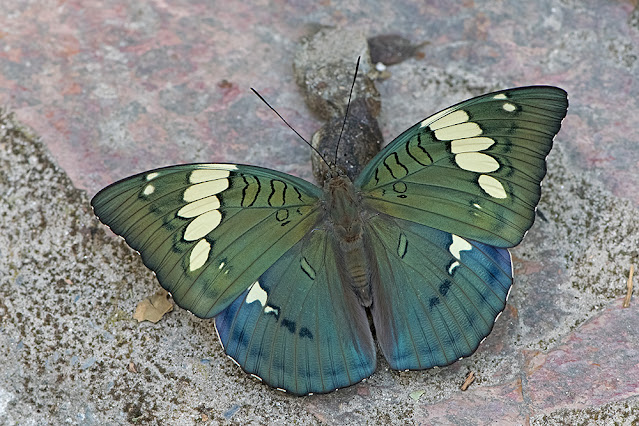
Photo taken at Doi Inthanon National Park, Chiang Mai, Thailand ♀ 1060m a.s.l.

Euthalia patala is not widely distributed and although not rare it is quite uncommon and rather localised. It is confined to the northern parts of the region from the Himalayas in the northwest to China in the east with northern Thailand at its southerly limit. The sexes are very similar in appearance and are difficult to determine in the field, but the female is larger and slightly darker than the male. The female also has two additional small white spots in space 1b on the forewing but these are not always visible and one spot may be absent.
Possibly because of its apparent reliance on oak trees as the larval food source there are probably no more than one or two broods per annum. It is a large butterfly, one of the largest in its genus, and has a very strong and fast flight. It is hard to miss when in flight but it lands very quickly and can then be difficult to find if it is feeding or resting in the undergrowth. Very little is really known about this species and it needs further study.
Synonyms and previously used names: Adolias patala, Euthalia longi, Adolias doubledayii, Adolias taooana, Euthalia epiona, Bassarona patala
Taxonomy: Animalia - Arthropoda - Insecta - Lepidoptera - Nymphalidae - Limenitidinae - Euthalia - patala
Regional subspecies: E.p.patala (Nepal, Bhutan), E.p.taooana (NE India, Myanmar, Thailand, Laos, China)
Regional Distribution: India, Nepal, Bhutan, Myanmar, Thailand, Laos, China
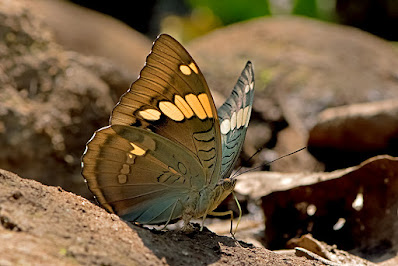 |
| Doi Suthep National Park, Chiang Mai, Thailand 1150m a.s.l. |
Habitat: Euthalia patala is found in deciduous montane forest and forest edges, near where their oak tree hosts are found. Usually seen at mid to high elevations and it has been recorded up to 1800m a.s.l.
Flight time: Spring to late summer but depending on location Wingspan: 80-100mm
Life History: not known
Larval Hosts: Quercus lamellosa, Quercus leucotrichophora, Quercus ramsbottomii (Fagaceae). Actual host plant used depends upon location and availabilty of plant species.
Adult Food Sources: Nectar - Geranium nepalense (Geraniaceae). There may be other plant species flowers that are visited but have not yet recorded or observed. Other - mud puddling, animal dung, over-ripe fruit
 |
| Doi Suthep-Pui National Park, Chiang Mai, Thailand |
 |
| Doi Inthanon National Park, Chiang Mai, Thailand |
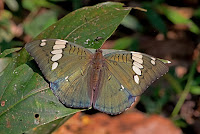 |
| Doi Suthep-Pui National Park, Chiang Mai, Thailand |
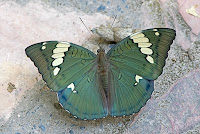 |
| Doi Inthanon National Park, Chiang Mai, Thailand |
 |
| Doi Inthanon National Park, Chiang Mai, Thailand |
 |
| Doi Suthep-Pui National Park, Chiang Mai, Thailand |
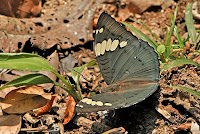 |
| Doi Suthep-Pui National Park, Chiang Mai, Thailand |
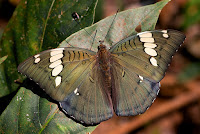 |
| Doi Suthep-Pui National Park, Chiang Mai, Thailand |
 |
| Quercus leucotrichophora, a larval host |
 |
| Quercus lamellosa, another larval host |
 |
| Geranium nepalense, a nectar source |
Links to other pages in this series for species in the same subfamily
Athyma perius
Auzakia danava
Euthalia alpheda
Euthalia lubentina
Lasippa viraja
Limenitis asura
Neptis cartica
Neptis miah
Pantoporia hordonia
Sumalia daraxa
Athyma pravara
Bhagadatta austenia
Euthalia anosia
Euthalia monina
Lebadea martha
Limenitis dudu
Neptis clinia
Neptis nashona
Pantoporia paraka
Sumalia zulema
Athyma ranga
Cynitia cocytus
Euthalia evelina
Euthalia patala
Lexias dirtea
Moduza procris
Neptis hylas
Neptis nata
Parthenos sylvia
Tanaecia jahnu
Athyma selenophora
Euthalia aconthea
Euthalia franciae
Euthalia phemius
Lexias pardalis
Neptis ananta
Neptis magadha
Neptis soma
Phaedyma columella
Tanaecia julii
